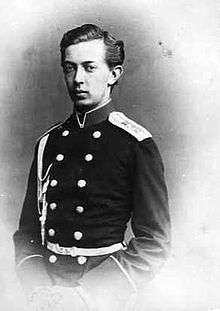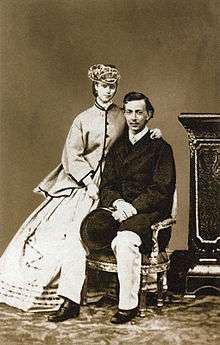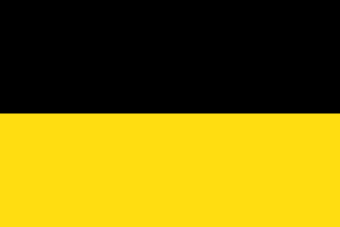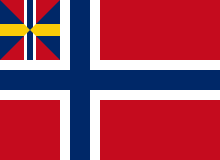Nicholas Alexandrovich, Tsesarevich of Russia
Nicholas Alexandrovich (Russian: Николай Александрович; 20 September [O.S. 8 September] 1843 – 24 April [O.S. 12 April] 1865) was tsesarevich—the heir apparent—of Imperial Russia from 2 March 1855 until his death in 1865.
| Nicholas Alexandrovich | |||||
|---|---|---|---|---|---|
| Tsesarevich and Grand Duke of Russia | |||||
 Nicholas Alexandrovich c 1863. | |||||
| Born | 20 September 1843 Saint Petersburg, Russian Empire | ||||
| Died | 24 April 1865 (aged 21) Villa Bermont, Nice, France | ||||
| Burial | Peter and Paul Cathedral, St. Petersburg, Russian Empire | ||||
| |||||
| House | Holstein-Gottorp-Romanov | ||||
| Father | Alexander II of Russia | ||||
| Mother | Marie of Hesse | ||||
Early life

Born at the Alexander Palace in St. Petersburg and nicknamed "Nixa", he was the eldest son of the Tsesarevich Alexander Nikolaevich, eldest son of Emperor Nicholas I, and the Tsarevna Maria Alexandrovna of Russia. In 1855, his paternal grandfather died, and his father succeeded to the throne as Emperor Alexander II.
Engagement

In the summer of 1864, Nicholas became engaged to Princess Dagmar of Denmark. She was the second daughter of King Christian IX of Denmark and Louise of Hesse-Kassel and was a younger sister of the Princess of Wales, later Queen Alexandra and wife of the heir-apparent to the British throne, Albert Edward, who reigned as Edward VII.
Death
Until 1865, Nicholas was thought to have a strong constitution, but early in that year, during a tour in southern Europe, he contracted an ailment that was initially incorrectly diagnosed as rheumatism. Nicholas's symptoms at that time included back pain and a stiff neck, as well as sensitivity to noise and light. He thought little of his ailments, however, and continued his tour in Italy.
His health rapidly worsened, and he was sent to Southern France, but this move brought him no improvement. It was eventually determined that he was suffering from cerebro-spinal meningitis, and it was speculated that this illness of his was caused by a previous accident in a wrestling match, in which Nicholas participated and was thrown down.[1] In the spring of 1865, Nicholas continued to decline, and he died on 24 April 1865, at the Villa Bermont in Nice, France.
It is believed that on his deathbed, Nicholas expressed the wish that his fiancée become the bride of his younger brother and future tsesarevich, Alexander, and in 1866, the couple was married.[2] Nicholas's death at the early age of 21 thoroughly devastated his mother, who was said to have pored obsessively over all aspects of Nicholas's life. Empress Maria never recovered from his death.
In 1867, construction was begun on a chapel named in his honor (fr:Chapelle du tsarévitch Nicolas Alexandrovitch) in Nice, on the exact place where Nicholas was said to have died, and in 1868, the chapel was inaugurated, with his brother Alexander and his wife, the re-christened Maria Feodorovna, in attendance.
Honours


.svg.png)
.svg.png)
.svg.png)
.svg.png)

Ancestry
| Ancestors of Nicholas Alexandrovich, Tsesarevich of Russia |
|---|
Notes
- F. R. Graham (1883). Life of Alexander II: Emperor of All the Russias. London. p. 180.
- "Med Guds Nåde WI ALEXANDER II". Finlands Allmänna Tidning (in Swedish). Helsinki: Grand Duchy of Finland (104): 1. 6 May 1865. Archived from the original on July 22, 2011. Retrieved 10 February 2009.
- "A Szent István Rend tagjai" Archived 22 December 2010 at the Wayback Machine
- Bille-Hansen, A. C.; Holck, Harald, eds. (1864) [1st pub.:1801]. Statshaandbog for Kongeriget Danmark for Aaret 1864 [State Manual of the Kingdom of Denmark for the Year 1864] (PDF). Kongelig Dansk Hof- og Statskalender (in Danish). Copenhagen: J.H. Schultz A.-S. Universitetsbogtrykkeri. p. 4. Retrieved 16 September 2019 – via da:DIS Danmark.
- M. & B. Wattel. (2009). Les Grand'Croix de la Légion d'honneur de 1805 à nos jours. Titulaires français et étrangers. Paris: Archives & Culture. p. 515. ISBN 978-2-35077-135-9.
- Bragança, Jose Vicente de; Estrela, Paulo Jorge (2017). "Troca de Decorações entre os Reis de Portugal e os Imperadores da Rússia" [Exchange of Decorations between the Kings of Portugal and the Emperors of Russia]. Pro Phalaris (in Portuguese). 16: 10. Retrieved 19 March 2020.
- "Caballeros de la insigne orden del toisón de oro", Guía Oficial de España (in Spanish), 1864, p. 155, retrieved 10 December 2019
- Sveriges och Norges Statskalender (in Swedish), 1864, p. 422, retrieved 2019-02-20 – via runeberg.org
References
- Nikolai Aleksandrovich Romanov, Grand Duke of Russia
- Zeepvat, Charlotte, Romanov Autumn, Sutton Publishing, 2000